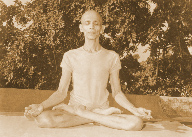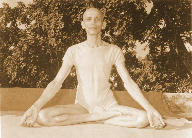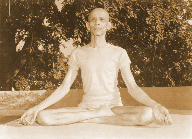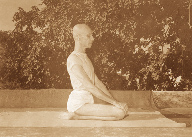Sitting Postures

| 
| 
| 
|
| Padmasana | Siddhasana | Svastikasana | Vajrasana |
PADMASANA (LOTUS POSTURE)TECHNIQUE
Sit over a folded blanket placed on even floor, with stretched legs. Always keep the spine and neck erect without bend. This is an instruction common to all the sitting postures. Bend the right leg at the knee and place the right foot on the thigh. Then, bend the left leg at the knee and place the left foot on the right thigh. Place the two hands with the palms facing up on the respective knee joints. Let the bent index fingers touch the middle portion of the thumbs and keep the other fingers stretched out. In the alternative, you can make the finger lock, and keep the locked hands over the left ankle. This may be convenient for some persons.
In the beginning, sit for ten minutes and gradually increase the duration according to your convenience.
SIDDHASANA (ADEPT'S POSTURE)
TECHNIQUE
Place one heel at the anus, the terminal opening of the alimentary canal or digestive tube. Keep the other heel at the root of the generative organ. The feet and the legs should be so nicely arranged that the ankle-joints should touch each other. Hands can be placed as in Padmasana.
SVASTIKASANA (CROSSED LEG POSTURE)
TECHNIQUE
Fold the left leg and place the feet near the right thigh muscles. Similarly, bend the right leg and push it in the space between the left thigh and calf muscles. Now you find the two feet between the thighs and calves of the legs. Place the hands as in Padmasana.
VAJRASANA (ADAMANTINE POSTURE)
TECHNIQUE
Kneel on the floor; slowly rest the buttocks in between the heels. The calf muscles must touch the thighs. The parts from the toes to the knees should rest on the ground. The entire weight of the body should rest on the knees and ankles. In the beginning of the practice, you may feel a slight pain in the knee and ankle joints, but it will pass away by gradual practice. Place the left and right hand palms on the respective knees. Keep the spine and neck erect. This may be a comfortable sitting posture for many persons.
BENEFITS
By sitting in any one of the above postures, the body acquires stability which results in the harmonious flow of blood and Prana (Vital Force) in the entire system, which is prerequisite for meditation. These sitting postures strengthen the waist, tone up the nervous system and balance the vital forces. If one sits in this Vajrasana for about half an hour immediately after food, the food will be digested well. The nerves, muscles of the legs and thighs are strengthened.
